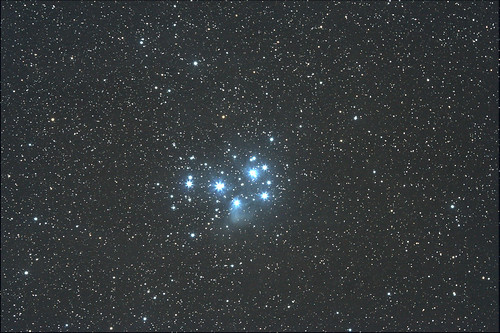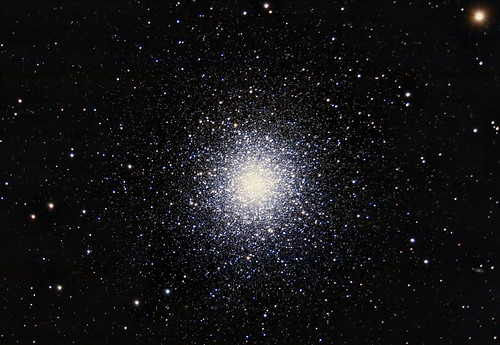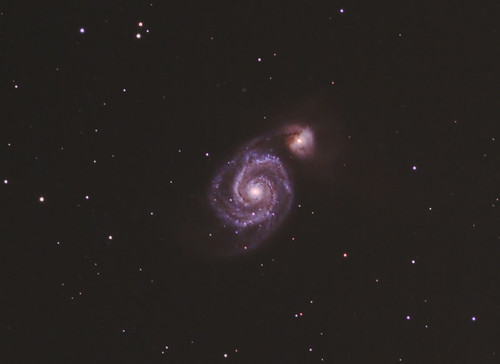In Gen. 15:1-6, God blesses Abraham and tells him that his reward will be great. Abraham asks what kinds of reward God can give him since Abraham is still childless. In response, God takes Abraham outside and instructs him to "look toward heaven and count the stars, if you are able to count them." God then informs Abraham "so shall your offspring be." That is, as numerous as the uncountable stars.
Our midrash here (1:3:36) picks up on this last line and tells a long parable. In short, a traveler, weary and hungry after traveling for a long time, found a really great tree. He ate its fruit, rested under its shade, and admired its beauty. The traveler wanted to bless the tree but realized the tree already had every good quality he could imagine. So the traveler blessed the tree and wished that "all the seedlings arising from you shall be like you."
God was in the same position with regard to Abraham, our midrash continues. God wanted to bless Abraham, but Abraham was already so righteous that God really had nothing to give Abraham. And so God blessed Abraham by decreeing "that all children who spring from you be like you."
At its simplest level, this midrash is quite sweet. We all love our children. People blessed with wonderful character qualities could still be blessed more if their children had the same wonderful qualities. Our children's blessing is our blessing.
As nice as this midrash is, it simply was not the lesson of the original Torah story. In the Torah, God was making a quantitative blessing: don't worry about not having any children right now, Abraham, you are going to have lots of descendants. As many as the stars, in fact. But God fails to tell Abraham what these descendants will be like. In contrast, the midrash has God making a qualitative blessing: your descendants are going to have your wonderful character traits. But God fails to tell Abraham how many of them there will be.
These stories are not actually contradictory; after all, Abraham could have many descendants, all of whom are wonderful, and thereby satisfy both stories. But nothing in the midrash implies that it is expanding on the Torah with a new blessing; it seems only to be explaining the Torah's original blessing. But it simply is not. What are we to make of this fundamental discrepancy?
My lawyerly reaction is to note that the midrash's analogy does not hold and write this off as sloppy reasoning. This approach might work with halacha, but we are dealing with midrash. And the proper response to a logical error is to go forward, not backwards. The question now become what do we learn from the midrash's conflation of quantity and quality?
And the answer, or at least my answer, lies in the Torah's suggestion to Abraham that he look at the stars to understand this blessing. Let's do that.
Every star, when considered individually, is pretty spectacular. A star is a giant fusion reaction ball, emitting so much light and heat that it can sometimes sustain life on the planets spinning around it.
The problem is that from our perspective, it is hard to look at and consider most stars individually. Every star (except our sun) is so far away that is only appears to us as a point of light, even in the largest telescopes. Unlike the planets in our solar system, we cannot magnify a star so that we see it as a disk. That makes it hard for us to look at a star and think about its individual qualities. But when we consider some stars collectively, we star to see some amazing things.
Here is Albireo,
 an easily visible double-star in the constellation Cygnus. These two stars are so close to each other that to the naked eye, they look like a single star. But in a small telescope, the space between the two stars is sufficiently magnified and the second star appears clearly separated from the first. The brighter star is yellow-orange, and the dimmer star is blue. The first time I saw these stars in a telescope, I was stunned by the vivid contrast between their colors. (I nicknamed this the UCLA star, after UCLA's school colors.) Regardless of their actual color, most stars appear white when viewed by themselves. But these two stars stand in such sharp contrast only because they are so close together and so vivid. This pair, as a pair, takes on an aspect of beauty that would be absent if each star were viewed individually.
an easily visible double-star in the constellation Cygnus. These two stars are so close to each other that to the naked eye, they look like a single star. But in a small telescope, the space between the two stars is sufficiently magnified and the second star appears clearly separated from the first. The brighter star is yellow-orange, and the dimmer star is blue. The first time I saw these stars in a telescope, I was stunned by the vivid contrast between their colors. (I nicknamed this the UCLA star, after UCLA's school colors.) Regardless of their actual color, most stars appear white when viewed by themselves. But these two stars stand in such sharp contrast only because they are so close together and so vivid. This pair, as a pair, takes on an aspect of beauty that would be absent if each star were viewed individually.Stars not only form pairs,
 but they form "open clusters", which are essentially a bunch of stars hanging out together. Take a look the Pleiades in Taurus (or M45, as astronomy buffs call it), a well-known open cluster. The Japanese refer to this cluster as "Subaru," and the Subaru car logo is a rendering of these stars. Their collective beauty is considerably more spectacular than their beauty considered individually. This cluster appears as a smudge at first, but then one can make out a few faint individual stars. But in a pair of binoculars or a small telescope, one sees more and more faint stars, all very close together and all brighter than the other stars in the area.
but they form "open clusters", which are essentially a bunch of stars hanging out together. Take a look the Pleiades in Taurus (or M45, as astronomy buffs call it), a well-known open cluster. The Japanese refer to this cluster as "Subaru," and the Subaru car logo is a rendering of these stars. Their collective beauty is considerably more spectacular than their beauty considered individually. This cluster appears as a smudge at first, but then one can make out a few faint individual stars. But in a pair of binoculars or a small telescope, one sees more and more faint stars, all very close together and all brighter than the other stars in the area.The Pleiades are a relatively small cluster. Take a look at M13,
 the great globular cluster in the constellation Hercules. This star cluster is composed of several hundred thousand stars, the brightest of which has an apparent magnitude of about 12. (The larger the number the dimmer the star. The dimmest star we can see with the naked eye is about 6.) It is absolutely impossible to see any particular star in M13 with the naked eye, binoculars, or even most small or medium telescopes. Nonetheless, the star cluster itself is spectacular. The sheer number of stars blend together with a brighter core gradually fading towards the edges. M13 a wonderful sight in a small telescope. When I first saw this star cluster, I thought it looked a pile of sugar God spilled in the sky.
the great globular cluster in the constellation Hercules. This star cluster is composed of several hundred thousand stars, the brightest of which has an apparent magnitude of about 12. (The larger the number the dimmer the star. The dimmest star we can see with the naked eye is about 6.) It is absolutely impossible to see any particular star in M13 with the naked eye, binoculars, or even most small or medium telescopes. Nonetheless, the star cluster itself is spectacular. The sheer number of stars blend together with a brighter core gradually fading towards the edges. M13 a wonderful sight in a small telescope. When I first saw this star cluster, I thought it looked a pile of sugar God spilled in the sky.One final example. The three previous star groupings consisted of stars in our galaxy.
 But the Whirlpool Galaxy, M51, in Canes Venatici, is a separate galaxy entirely. We cannot make out individual stars at all; it is simply too far away. But the zillions of stars in this galaxy make it easy to see in a small telescope (but not with the naked eye, and only slightly in binoculars). And this galaxy is perfectly positioned for seeing its spiral structure. We see it face on, and even a small telescope shows its twirling spiral arms. It is one of my favorite deep space objects. Also, it is interacting with the smaller galaxy near it (NGC 5195). Again, this huge quantity of stars, acting collectively, provide a type of beauty that individual stars alone cannot.
But the Whirlpool Galaxy, M51, in Canes Venatici, is a separate galaxy entirely. We cannot make out individual stars at all; it is simply too far away. But the zillions of stars in this galaxy make it easy to see in a small telescope (but not with the naked eye, and only slightly in binoculars). And this galaxy is perfectly positioned for seeing its spiral structure. We see it face on, and even a small telescope shows its twirling spiral arms. It is one of my favorite deep space objects. Also, it is interacting with the smaller galaxy near it (NGC 5195). Again, this huge quantity of stars, acting collectively, provide a type of beauty that individual stars alone cannot.So with these vivid examples in mind, we return to the Torah and the midrash. The Torah tells us that God blessed Abraham with lots of descendants. The midrash tells us that God blessed Abraham with descendants with wonderful qualities. And I harmonize these by noting that some spectacular qualities only appear where there is a sufficient underlying quantity.
A well-functioning family takes on qualities beyond the sum of its parts. So do friends, study partners, minyans, havurot, schools, synagogues, federations, Jewish denominations, the State of Israel, and the Jewish people as a whole.
My wish is that we may all merit Abraham's blessings from the Torah as expanded in the midrash. May we all be wonderful people like Abraham. But may our marriages, individual friendships, and every other two-person relationship be as wonderful as Albireo. May our families, set of friends, co-bloggers, and all other small groups be as wonderful as the Pleiades. May the Jewish communities in cities be as wonderful as M13, and may the Jewish people as a whole be as spectacular as the Whirlpool Galaxy.





3 comments:
Thanks so much for this *spectacular* post, Bruce. Truly a stellar example of how richly, marvelously free-ranging and inspiring this blog can be!
If we had a "best of..."
Thank you both. The midrash is certainly a rich source of material --- it deserves most of the credit. And astronomy the rest. : )
Post a Comment